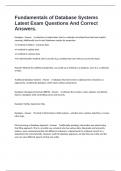Exam (elaborations)
Fundamentals of Database Systems Latest Exam Questions And Correct Answers.
- Course
- Institution
Database - Answer A collection of related data, that is a collection of related facts that have implicit meaning. Additionally (not in text) databases require for properties: • A method to define / construct data. • A method to update data. • A method to retrieve data. • An administr...
[Show more]



